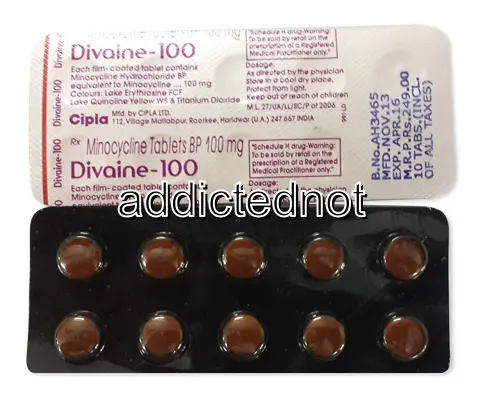| Package | Dosage | Price | Price per Dose | |
|---|---|---|---|---|
| Dosage: 50mg | ||||
| 240 pill | 50mg | €850.99 | €3.54 | |
| 120 pill | 50mg | €447.81 | €3.73 | |
| 90 pill | 50mg | €357.09 | €3.97 | |
| 60 pill | 50mg | €247.66 | €4.12 | |
| 30 pill | 50mg | €129.58 | €4.31 | |
| Dosage: 100mg | ||||
| 180 pill | 100mg | €728.60 | €4.05 | |
| 120 pill | 100mg | €519.81 | €4.33 | |
| 90 pill | 100mg | €420.45 | €4.67 | |
| 60 pill | 100mg | €302.37 | €5.04 | |
| 30 pill | 100mg | €161.26 | €5.36 | |
| 10 pill | 100mg | €54.70 | €5.53 | |

Minocycline Description
Overview of Minocycline
Minocycline is a broad-spectrum antibiotic belonging to the tetracycline class. It is commonly used to treat various bacterial infections due to its ability to inhibit bacterial protein synthesis. The medication is often prescribed for skin conditions, respiratory infections, urinary tract infections, and some sexually transmitted diseases. Its effectiveness depends on proper dosage and adherence to the prescribed course.
Mechanism of Action
Minocycline works by binding to the 30S ribosomal subunit of bacteria. This action prevents the attachment of transfer RNA (tRNA) to the mRNA-ribosome complex. Consequently, it inhibits the addition of amino acids to the growing polypeptide chain, halting bacterial growth. This bacteriostatic effect helps the immune system to eliminate the infection more effectively. The drug's ability to penetrate tissues well makes it particularly useful for skin infections and acne treatment.
Usage and Dosage
Typically, minocycline is administered orally in the form of capsules or tablets. The dosage varies depending on the infection being treated, patient age, and overall health. For skin conditions like acne, lower doses over a longer period are common, while more severe infections may require higher doses for a shorter duration. It is crucial to follow the healthcare provider's instructions precisely to minimize side effects and prevent antibiotic resistance.
Potential Benefits
Many users report positive results when using minocycline. It is especially effective for treating acne, reducing inflammation and bacteria on the skin. In cases of respiratory and urinary tract infections, the medication often leads to rapid symptom relief. Additionally, minocycline’s ability to penetrate tissues makes it a good choice for internal infections that are difficult to reach with other antibiotics.
Possible Side Effects
Like all medications, minocycline can cause side effects. Common issues include nausea, dizziness, and discoloration of the teeth or skin in some cases. More serious but less frequent side effects involve allergic reactions, liver problems, or intracranial pressure. Long-term use may also increase the risk of yeast infections or overgrowth of resistant bacteria. Customers should always report any adverse effects to their healthcare provider promptly.
Precautions and Warnings
Minocycline should be used with caution in individuals with a history of allergies to tetracyclines. Pregnant women and nursing mothers are advised to avoid this medication unless prescribed otherwise, as it can affect fetal development and breastfeeding infants. It is also important to avoid excessive sun exposure, as the drug can make skin more sensitive to sunlight, increasing the risk of sunburn.
Storage and Handling
The medication should be stored at room temperature away from moisture and heat. Keep it out of children’s reach to prevent accidental ingestion. Proper storage ensures the drug’s effectiveness and maintains safety. Always dispose of unused medication responsibly, following local guidelines for medication disposal.
Conclusion
Minocycline remains a valuable antibiotic for treating a variety of bacterial infections. Its broad spectrum and tissue penetration make it effective for conditions like acne, respiratory infections, and specific skin disorders. However, users must be aware of potential side effects and adhere closely to medical advice. Proper monitoring during therapy helps ensure safe and successful treatment outcomes.
